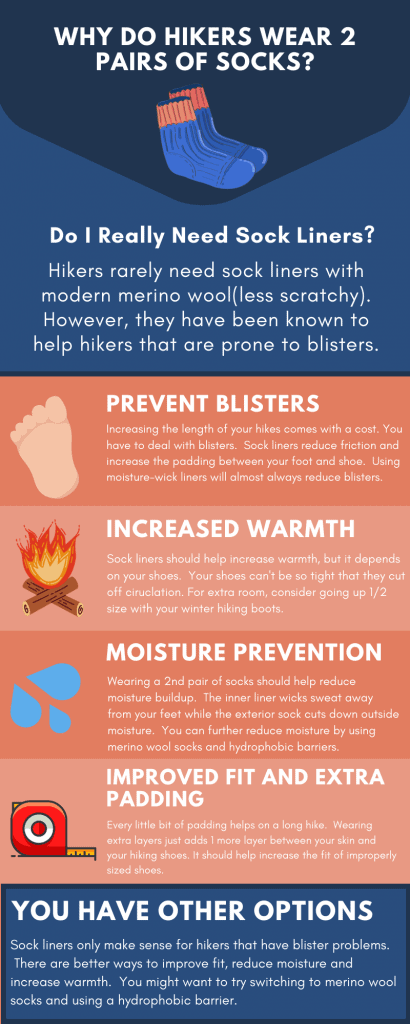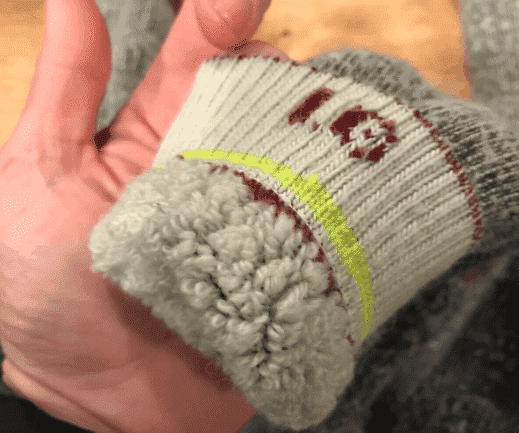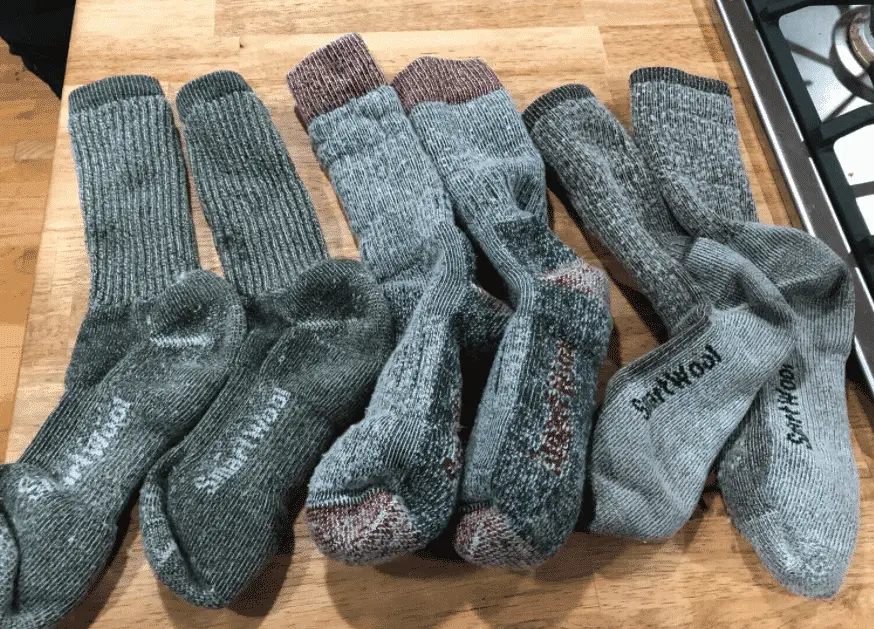Do you ever wonder why some hikers wear 2 pairs of socks? It can’t just be a fashion statement! So why do hikers and backpackers insist on wearing multiple pairs of socks? Is it all about layering or does it offer some other type of protection?
Why do hikers wear two pairs of socks? There are two main reasons why hikers double up their socks. They’re either trying to increase warmth by layering or attempting to avoid blisters. Although doubling up socks usually isn’t necessary, it may help.
Does doubling up on socks equate to double the protection? Probably not, but there’s a large community of backpackers that still insist on layering their socks. In this article, I’ll explain a few of the reasons why people layer their socks and offer an alternative method that also works.
Table Of Contents
Should I Wear Two Pairs of Socks While Hiking?

Back in the old days, the standard advice was to wear two pairs of socks. You would wear a thin comfortable liner against your skin and itchy wool socks(they felt like brillo pads).
The second pair of socks was to protect your legs against the itchy wool. It served no other purpose! Less friction between your skin and the wool means less irritation, but times have changed.
Modern merino wool is downright luxurious! It’s insanely soft compared to everything else on the market. You can’t go wrong with any of the following merino wool sock options.
- Darn Tough (Expensive and Extremely Durable): Darn Tough socks are by far the most durable socks on the market.
- Smartwool (Cheap and Comfortable): I usually just stick to Smartwool Socks. They’re always cheap, warm and extremely comfortable. Smartwool socks might not be as durable, but they last longer than you think.
- Icebreaker (Mid-Priced and Durable): Icebreaker split the line between comfort and durability. They’re affordably priced and offer great durability, but less comfortable than Smartwool.
Just avoid generic/cheap merino wool socks. They might last for occasional use around the house, but they won’t last on the trail. You’ll end up with fraying wool and tiny holes everywhere.
Does Wearing 2 Pairs of Socks Help?
It’s hard to say whether or not 2 pairs of socks will help you. It depends on whether or not your feet irritate easily. Definitely try sock liners if you get the occasional blister.
- Prevent Blisters: There’s no rhyme or reason as to why some people are more susceptible to blisters than others. You should definitely try a thin sock liner (I Like Smartwool Liners) if you regularly get blisters. The liner rubs against the sock instead of your skin, plus it offers extra padding.
- Increase Warmth: Wearing 2 pairs of socks to increase warmth is a dangerous game. Whether or not it works depends on the size of your shoes. If your shoes are tight it cuts off circulation and makes matters worse. I like to go 1/2 size up on my winter hiking boots for extra room.
- Moisture Prevention: Eliminating moisture will both reduce blisters and help regulate the temperature of your feet. With the right socks, your feet will be cool in the summer and warm in the winter.
You’re the only one that can decide if wearing a liner is worth it. I was able to cut down blisters by switching to merino wool and using a hydrophobic barrier on my feet. Products like Desitin and Foot Glide help cut down moisture and reduce friction.
Blister Prevention
Blister prevention is by far the biggest reason why most hikers decide to wear 2 pairs of socks. Everybody has experienced blisters on their feet at some point in their life. They’re very painful and hard to deal with on the trail.
There isn’t much you can do after you get a blister. Blister prevention is all about reducing friction before it turns into a problem. Why do hikers get blisters? They chose cotton or synthetic socks that rub the wrong way.
Do sock liners prevent blisters? Everybody is different! Wearing 2 pairs of socks can definitely help, but it’s not a miracle worker. It all depends on your specific circumstances and the strength of your skin.
You might need to work on slowly building up your mileage. Sometimes you just need to bite the bullet and suffer through a few blisters. Your skin will eventually toughen up and start to callus.
How Do Sock Liners Work?

To prevent blisters, you need to reduce friction, moisture and heat. Using a 2nd pair of socks reduces the amount of rubbing on your feet. It’s one more layer between your skin and your shoes.
Sock liners work by increasing the amount of padding and wicking moisture away from your feet. Dry feet rarely get blisters! You can further reduce moisture by using Desitin or Foot Glide. Desitin works better, but Foot Glide’s deodorant like applicator is cleaner and easier to use.
Extra Warmth and Improved Fit
Layering up socks could help increase warmth, but it depends on your shoe size. It’s hard to find the perfect shoe size. They can’t be too tight, but loose isn’t good either.
Tight shoes can cause circulation problems, which makes your feet colder. Wearing 2 pairs of socks will only exacerbate the problem. If you plan on wearing sock liners increase 1/2 shoe size.
There’s a fine line between the perfect fit with liners and being oversized. Too much room cause friction problems and blisters.
Moisture Prevention
Removing moisture will almost always eliminate blisters. Do your socks look white and pruny after a long hike? That means you have too much moisture and you might be experiencing the first stage of trench foot.
Sock liners just add an extra layer of protection. The inside socks pull moisture away from your feet reducing sweat and the outside socks hold back exterior moisture. Plus you can swap out the liner everyday and always feel like you’re putting on clean socks.
A Brief Introduction To 2 Sock Systems

Not everybody will like wearing 2 pairs of socks. You need to learn how to layer your socks properly. Cheap cotton and synthetic socks will do more harm than good.
- First Layer: The sock closest to your feet should be a thin layer made out of silk, nylon, polyester or merino wool(my favorite). It should be a lightweight, moisture-wicking liner that should have a snug fit (Avoid Cotton). Your liner doesn’t have to be super expensive. I prefer Fox River and Smartwool liners, but some people use regular old dress socks.
- Second Layer: Merino wool is the only choice for an outer layer. Cotton/Synthetic blends just can’t handle moisture. Spend the extra money on premium brands like Darn Tough, Smartwool, and Icebreaker. There’s just no quality control with budget wool socks.
Do I Really Need Hiking Socks?
Whether or not you need dedicated hiking socks depends on your mileage. You can usually get away with cotton/synthetic socks on short hikes. As you increase the mileage you will want to switch over to merino wool.
Merino wool helps battle moisture and reduce friction/blisters. It really is a miracle worker. Your feet stay warm in the winter and cool in the summer. Plus the anti-microbial properties will help reduce bacteria growth and smell. You can usually wear merino wool for multiple days before they start to smell.


